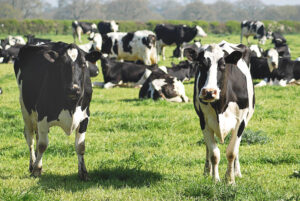Milk production has been essentially flat for the past three years, and 2024 is on track for another year at the same level, if not less. On the surface, that may seem uninspiring. However, there are two underlying developments hidden from the headline number that suggest that producers are far from flatlining: That steady amount of milk is being produced by fewer cows, and the milk is richer in components. In 2021, U.S. producers made 226.2 billion pounds of milk. In 2022, that number increased by less than one-tenth of a percent to 226.4 billion pounds, where it remained in 2023. To be sure, there were seasonal differences and regional shifts, but when blended at the national level, steady. But “steady” isn’t necessarily compatible with the mindset of the typical growth-oriented U.S. dairy producer. For the years leading up to this plateau, a 1.5% annual increase in production was a reliable rule of thumb. Milk cow prices are high. And much of that is driven by strong beef markets. Higher beef values increase incentives to cull less-productive cows and divert more calves toward dairy/beef cross programs rather than milk cow replacements. With milk cow values so high, and so much of that value being driven by beef values rather than milk values, the cows that maintain their position in the milking herd have earned their right to be there through strong production. In 2021, 226 billion pounds of milk was produced by 9.45 million cows. By 2023, 123 million more pounds of milk was produced by 63,000 fewer cows. But this isn’t all standardized 3.5% milkfat milk headed for plastic jugs. Consumers want their milk in the form of cheese and butter and other dairy products. Manufacturers of those products need components like fat and protein. Milkfat on the Rise The average milkfat test in the U.S. was: 4.01% in 2021 (the first year the annual average topped 4%) 4.08% in 2022 4.14% in 2023 So far, through April 2024, the average fat test is 4.29%, compared with 4.19% for the same period in 2023. The fact that the average cow is producing higher milkfat percentages is offsetting the fact that there are fewer cows (see Chart). The total milkfat produced in the U.S. continues to grow year after year. From 2022 to 2023, milkfat increased by 136.2 million pounds, or 1.5% year over year. It’s time for the dairy sector to think about milk beyond just standardized 3.5% butterfat terms and milk equivalents, instead shifting perspective to the component level. Producers looking at the headline milk production level may be lulled into thinking we are stagnating as an industry. But there is a lot going on with milk per cow yield and component production, which are more important benchmarks to measure yourself against to get ahead.
More Articles
See All InsightsFarmers should stay patient and disciplined. Patient for old crop: I expect continued price rallies for old-crop corn driven by export sales strength and tight global
Stronger-than-expected economic growth amid poorer consumer sentiment. Geopolitical tensions fueling multiple regional wars. A change in the White House. A change in the Senate majority. Somewhat
Persistently tight milk supply created an opportunity for strong exports to drive prices to new heights for the year. But the new price level could be



